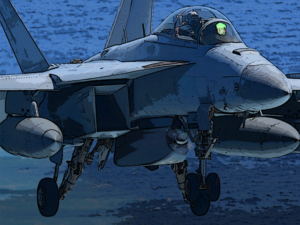Naval Air Systems Command (NAVAIR) said Monday it recently started the final Demonstration of Existing Technologies (DET) tests for the Next Generation Jammer Low Band (NGJ-LB) capability.
The NGJ-LB capability is part of how NAVAIR aims to augment and replace the legacy ALQ-99 tactical jammer system on the EA-18G Growler by splitting it into three increments of low, mid, and high band frequencies. The service aims to use these electronic attack capabilities to help counter or defeat enemy air defenses and communications systems.

NAVAIR said tests are being conducted through the summer at the Air Combat Environmental Test and Evaluation Facility and the Facility for Antenna and RCS Measurement (FARM) at Naval Air Station Patuxent River, Md.
“The 20-month DET contract has been a collaborative effort with industry partners to assess technical maturity,” the Navy said in a statement.
In 2018, the Navy awarded Northrop Grumman [NOC] and L3Harris [LHX] $35 million contracts to demonstrate and test technologies for the NJG-LB. Raytheon Technologies [RTX], which is building the mid-band pod for the NGJ, had previously lost a bid protest of its loss in the low-band section. (Defense Daily, Oct. 26, 2018)
Capt. Michael Orr, program manager of PMA-234 which oversees to NJG-LB program, said this is an exciting time for the government and industry teams and noted it still occurred amid the COVID-19 pandemic.
“It’s the culmination of almost two years in the making. I’m very proud, despite the current CoVID-19 environment, that our collective government and industry teams continue to focus on delivering fleet capability while also maintaining health and safety protocol,” Orr added.
NGJ-LB Deputy Program Manager Leon Smith underscored Northrop Grumman and L3Harris have completed eight “significant test events” since their initial 2018 awards.
“NGJ-LB is the next step in the evolution of Airborne Electronic Attack that is needed to meet current and emerging electronic warfare gaps, and our team is dedicated to delivering this capability to the fleet as quickly as possible,” Orr added.
Separately, on May 12 Northrop Grumman announced it expanded in NGJ-LB Capability Block 1 (CB-1) solution team by adding CPI Aero, Inc.
The company explained it submitted its proposals for NGJ-LB in January and has been moving toward CB-1 execution. CPI Aero will provide the pod structure and assembly.
Northrop Grumman underscored CPI Aero is already the current supplier of record for pod structure and assembly on the ALQ-249 NGJ Mid-Band program.
“The addition of CPI Aero to our NGJ-LB team will help provide rapid fleet capability to the Navy. They have extensive experience in providing aircraft and pod structural components for several Department of Defense customers and we are proud to have them on our team of EW engineering and mission experts, helping the Navy maintain its warfighting edge through advanced airborne electronic attack (AEA) capabilities,” Paul Kalafos, vice president, surveillance and electromagnetic maneuver warfare at Northrop Grumman, said in a statement.